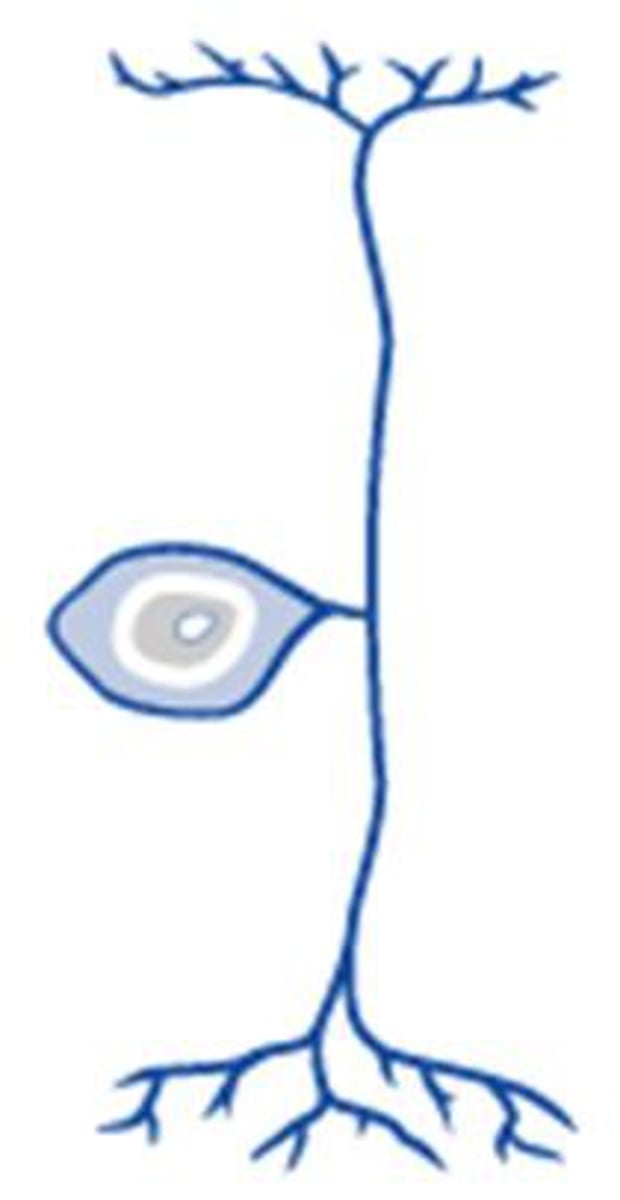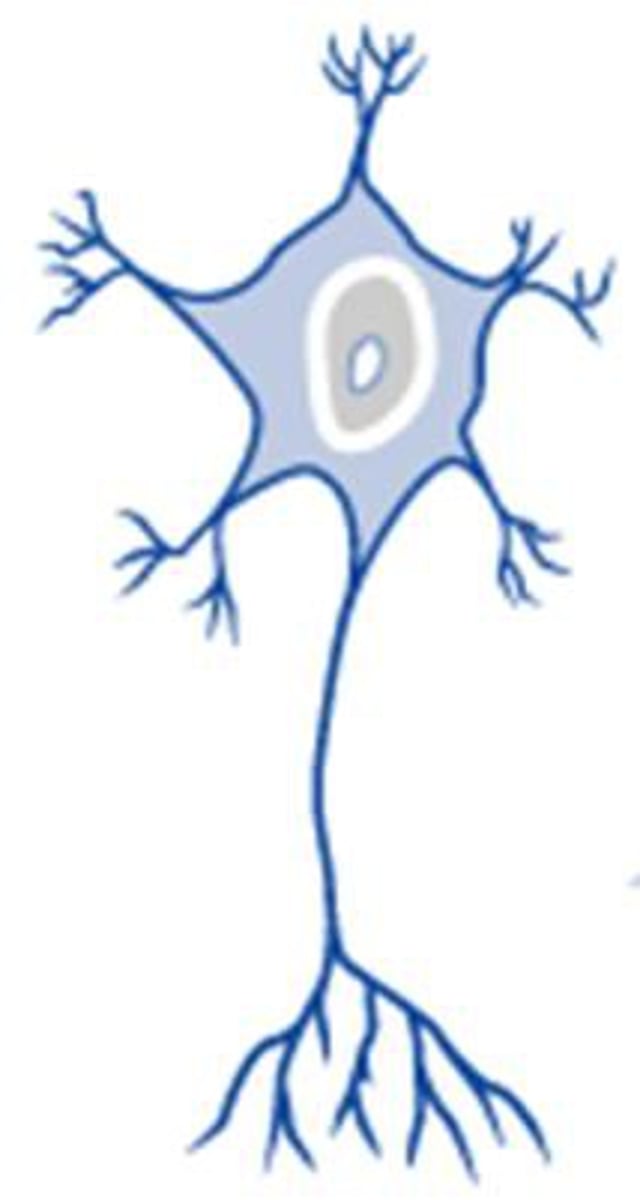Biology 30 Alberta: Nervous System
1/82
There's no tags or description
Looks like no tags are added yet.
Name | Mastery | Learn | Test | Matching | Spaced |
|---|
No study sessions yet.
83 Terms
What does the nervous system coordinate?
The internal environment and responds to external changes
Are the nervous system and endocrine system interrelated?
Yes
What are the two major divisions of the nervous system?
Peripheral nervous system (sensory and motor neurons) and the central nervous system (brain and spinal cord)
What is the motor component of the peripheral nervous system further divided into?
Somatic nerves (under conscious control) and autonomic nerves (under involuntary control)
Central nervous system (CNS)
The body's coordinating centre for mechanical and chemical actions (brain and spinal cord)
Peripheral nervous system (PNS)
All parts of the nervous system, excluding brain and spinal cord, that relay information between the CNS and other parts of the body
What are the two types of cells in the nervous system?
Neurons and glial
What are neurons?
Functional units; specialized to respond to chemical and physical stimuli, to conduct electrochemical signals and release chemicals that regulate body processes (conducts nerve impulses)
What are glial cells?
Non cunducting cells, give structural support, provide nutrients, and remove wastes from neurons (outnumber neurons 10X)
How many glial cells are there per neuron?
10
What four features are common to all neurons?
Dendrites, cell body (soma), axon, and terminal ends
What are dendrites?
Short, branching terminals that receive nerve impulses from other neurons or receptors and relay messages to the cell body
What is the cell body (soma)?
The site of metabolic reactions (contains nucleus)
What is the axon?
Conducts impulses away from the cell body (can range in length from 1mm to 1m). Some are enclosed in a fatty, insulated layer called myelin sheaths (myelinated axons appear white, unmyelinated axons appear grey). Myelin sheath is secreted by Schwann cells (type of glial cell). Small gaps between the sheath, Nodes of Ranvier, allow the impulse to jump along the axon
What are terminal ends?
Branched ends of axons, site of neurotransmitter release
What is a myelin sheath?
White coat of fatty protein, acts as insulation for the neurons
What is a Schwann cell?
A special type of glial cell that produces the myelin sheath
What are Nodes of Ranvier?
Regularly occurring gaps between sections of the myelin sheath along axon
What is the neurilemma?
Delicate membrane that surrounds the axon of some nerve cells, promotes the regeneration of damaged axons (not all nerve cells that have a myelin sheath have a neurilemma)
What are the three functional types of neurons?
Sensory (unipolar), motor (multipolar), and interneurons (bipolar)
Unipolar neuron
Sensory neuron (afferent)

Bipolar neuron
Interneuron

Multipolar neuron
Motor neuron (efferent)

What do sensory (afferent) neurons do?
Relay information to stimuli received by sensory receptors about the internal and external environment to the central nervous system for processing
What do interneurons do?
Links neurons to other neurons, found only in brain and spinal cord, integrate and interpret the sensory information and connect to outgoing motor neurons
What do motor (efferent) neurons do?
Relay information to the effectors (the cell or organ that responds to the stimulus). Muscles, organs and glands are classified as effectors because they produce responses
What are individual neurons organized into?
Nerves
What are reflexes?
Rapid, involuntary, and unconcious responses
What are the five components of a reflex arc?
A SENSORY RECEPTOR to detect the stimulus, a SENSORY NEURON to pass an impulse to an INTERNEURON, which relays the information to a MOTOR NEURON, which initiates an EFFECTOR
How quickly do reflexes travel?
Less than one second (some take less than 50 ms)
What do sensory receptors do in impulse transmission?
Receive stimuli from the internal and external environment and form nerve impulses
What do sensory neurons do in impulse transmission?
Transmit impulses from the sensory receptors to the interneurons (CNS)
What do interneurons do in impulse transmission?
Found in brain and spinal cord, act as integration and interpretation centre. Link neurons to other neurons (sensory to motor)
What do motor neurons do in impulse transmission?
Conduct impulses from the interneurons to the effectors
What do effectors do in impulse transmission?
Muscles, glands and organs that respond to the impulses from the motor neurons. Produce responses
What is membrane potential?
A voltage or electrical charge across the plasma membrane
What is the voltage difference across a nerve cell when it is not transmitting an impulse?
-70 mV
Which two mechanisms create the voltage difference across a nerve cell (when it is not transmitting an impulse)?
The membrane (impermeable to large, negative proteins and negative ions) and the sodium-potassium pump (pumps more Na+ out than it brings K+ ions in)
How do ions travel across the membrane of a nerve cell?
They rely on facilitated transport (using voltage gated ion channels)
Are there more K+ channels or Na+ channels in the membrane of a nerve cell?
More K+
What happens as K+ leaves the nerve cell?
It causes a build up of (+) charge on the outside because the negatively charged proteins or Cl- can't move across
The movement of ___ ____ is mainly responsible for creating electric potential
K+ ions
What would happen if movement of ions across a nerve cell membrane was left to diffusion alone?
The K+ concentration on both sides of the membrane would eventually even out
How many K+ and Na+ ions are moved by the sodium-potassium pump? In which direction? Using what?
K+: 2 back into cell
Na+: 3 out of cell
Transported by active transport using ATP energy
When does an action potential occur?
When the resting potential changes from -70 mV to -55 mV
What is the threshold potential?
-55 mV
What is the change from -70 mV to -55 mV called?
Depolarization
On myelinated axons, where does depolarization occur?
At the Nodes of Ranvier
When depolarization occurs, do voltage-gated Na+ channels open or close?
Open
When depolarization occurs and Na+ rushes into the axon, what is the new potential difference?
+35 mV
What does the change in voltage to 35 mV cause?
Na+ channels close and K+ voltage-gated channels open
What happens when K+ rush out of the axon?
They carry the positive charge out and repolarize the membrane to -90 mV
What is the 'overshoot' due to?
The K+ gates close slowly
What is the 'overshoot' period called?
The refractory period (or hyperpolarization)
Can action potentials be transmitted when the nerve cell is not at resting potential?
No (nerve cell must be at resting potential)
What does the speed of an action potential increase with?
The diameter of an axon
Do myelinated axons increse the speed of an impulse?
Yes (action potential jumps from node to node; saltatory conduction)
What is saltatory conduction?
The 'leaping' of action potentials along myelinated axons from one node of Ranvier to the next node, increasing the conduction velocity of action potentials
What are the spaces between neurons or a neuron and effector called?
Synapses
What is a presynaptic neuron?
The 'sending' neuron (neuron conducting impulses toward synapse)
What is a postsynaptic neuron?
The 'receiving' neuron (neuron transmiting impulses away from the synapse)
When an impulse reaches the terminal end, what must it do?
Cross the gap from the presynaptic neuron to the postsynaptic neuron
What does the action of an impulse crossing the synapse rely on?
Chemical messengers called neurotransmitters
What are neurotransmitters?
Chemical messengers (released at the end of a nerve fiber by the arrival of a nerve impulse and, by diffusing across the synapse or junction, causes the transfer of the impulse to another nerve fiber, a muscle fiber, or some other structure)
What are contained within the terminal ends of axons?
Tiny vesicles that contain neurotransmitters
What does the action potential reaching the synaptic knob cause?
Calcium channels to open and Ca2+ to move in
What triggers the release of neurotransmitters from synaptic vesicles?
The action potential reaching the synaptic knob, which causes calcium channels to open and Ca2+ to move in
Where do neurotransmitters (released from synaptic vesicles) release their contents into?
The synaptic cleft
What do neurotransmitters do after they have been released into the synaptic cleft?
They diffuse across the 20 nm gap and bind to receptors in the postsynaptic membrane
Where do neurotransmitters bind to?
The postsynaptic membrane (either on the dendrites of a neuron or the cell membrane of an effector)
What does the binding of neurotransmitters to receptors cause?
Specific voltage gates to open
What happens if neurotransmitters are excitatory?
Na+ gates open, causing a depolarization and continued transmission
What happens if neurotransmitters are inhibitory
K+ gates open, causing hyperpolarization and transmission stops
Why are inhibitory neurotransmitters important?
They allow information to be prioritized, and help to coordinate complex movements
What happens to a neurotransmitter once it has had an effect?
It is broken down by enzymes and the components are recycled
What is acetylcholine?
An important neurtransmitter in muscle control
What happens to acetylcholine after it has bound to its receptor?
It is broken down by the enzyme cholinesterase
What is cholinesterase?
An enzyme that breaks down acetylcholine
What does acetylcholine do when it is bound to a receptor (before it is broken down)
Creates a depolarization that initiates a muscle contraction
What would happen if acetylcholine is not broken down by cholinesterase?
Muscles will remain in a state of constant contraction, causing side effects like tremors, heart palpitations, or paralysis
What is summation?
The effect produced by the accumulation of neurotransmitters from two or more neurons (to meet the threshold level of the receptors in the dendrites)
What are some examples of neurotoxins?
Botulinium and tetanus
What are neurotoxins?
Bacterial proteins that are exocytosed into nerve endings where they inhibit the release of essential neurotransmitters